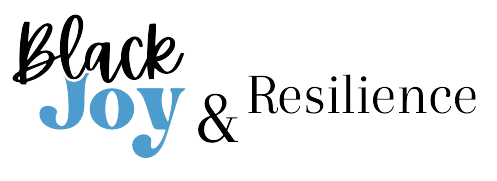Items
Tag
Storytelling
-
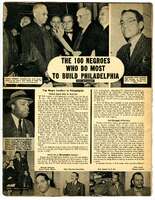 The 100 Negroes Who Do Most To Build Philadelphia Color Magazine, February 1950. Ira James Kohath Wells (1898–1997), founder of Color magazine, was born in Tamo, Arkansas. He earned a business degree from Lincoln University in 1923, where he co-founded the Colored Student Movement and joined the Student Anti-Lynching delegation to President Warren Harding.
The 100 Negroes Who Do Most To Build Philadelphia Color Magazine, February 1950. Ira James Kohath Wells (1898–1997), founder of Color magazine, was born in Tamo, Arkansas. He earned a business degree from Lincoln University in 1923, where he co-founded the Colored Student Movement and joined the Student Anti-Lynching delegation to President Warren Harding. -
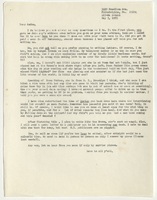 Letter from Anita Cornwell to Audre Lorde An impassioned letter between women who had a deep friendship. Audre Lorde (1934 - 1992) was an American poet, novelist, memoirist, essayist (IMDb, n.d.). She received a master’s degree in Library Science and worked as a young adult librarian and school librarian in the 1960’s (Cerro Cosco Community College 2025). She also published poetry influenced by her reactions to racism, sexism, and homophobia. She married and had two children. Her first major book of poetry, Coal was published in 1976, and she continued to publish until her death from liver cancer in 1992.
Letter from Anita Cornwell to Audre Lorde An impassioned letter between women who had a deep friendship. Audre Lorde (1934 - 1992) was an American poet, novelist, memoirist, essayist (IMDb, n.d.). She received a master’s degree in Library Science and worked as a young adult librarian and school librarian in the 1960’s (Cerro Cosco Community College 2025). She also published poetry influenced by her reactions to racism, sexism, and homophobia. She married and had two children. Her first major book of poetry, Coal was published in 1976, and she continued to publish until her death from liver cancer in 1992. -
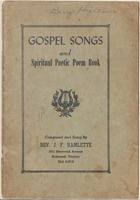 Gospel Songs and Spiritual Poetic Poem Book The book “Gospel Songs and Spiritual Poetic Poem Book” by Rev. J. F. Hamlette has four parts and is 56 pages. It has handwritten inscriptions of Ada and George Hightower's names on cover and inside, who were members of the First Colored Church in Hopewell, NJ and were among the first African Americans to live on Columbia Avenue in Hopewell.
Gospel Songs and Spiritual Poetic Poem Book The book “Gospel Songs and Spiritual Poetic Poem Book” by Rev. J. F. Hamlette has four parts and is 56 pages. It has handwritten inscriptions of Ada and George Hightower's names on cover and inside, who were members of the First Colored Church in Hopewell, NJ and were among the first African Americans to live on Columbia Avenue in Hopewell. -
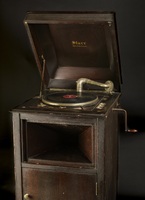 Standing Victrola Originally belonged to the Smith brothers (Alfonso, Clarence, Raymond, and Leon), who were born in Neshanic Station to Joseph Smith Jr. and Cora Smith of Pennington. The brothers pooled their money to purchase the Victrola for their family's enjoyment.
Standing Victrola Originally belonged to the Smith brothers (Alfonso, Clarence, Raymond, and Leon), who were born in Neshanic Station to Joseph Smith Jr. and Cora Smith of Pennington. The brothers pooled their money to purchase the Victrola for their family's enjoyment. -
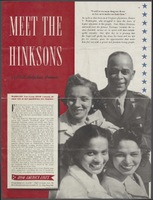 “Meet the Hinksons.” “Meet the Hinksons of Philadelphia, Penna.” is a six-page magazine article published in the Ladies’ Home Journal series “How America Lives” in August 1942. The article highlights the everyday life of the Hinkson family, including education, careers, fashion, travel, and home, and the impact of various wars on their lives.
“Meet the Hinksons.” “Meet the Hinksons of Philadelphia, Penna.” is a six-page magazine article published in the Ladies’ Home Journal series “How America Lives” in August 1942. The article highlights the everyday life of the Hinkson family, including education, careers, fashion, travel, and home, and the impact of various wars on their lives. -
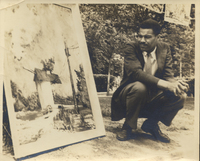 Photograph. Paul B. Moses with his painting Ice House Paul B. Moses (1929 - 1966) was born in Ardmore, Pennsylvania, attended Lower Merion High School and became one of the first Black undergraduates at Haverford College. Despite facing racism and isolation, he excelled in languages and art, studying abroad in France with the support of Albert C. Barnes, MD. After serving in the U.S. Army, he taught at institutions including the Barnes Foundation, Lincoln University, and at the American Overseas School in Rome before earning a Masters and pursuing a doctorate in art history at Harvard, where his dissertation specialized in Degas’s etchings (Moses and Scharff 2023).
Photograph. Paul B. Moses with his painting Ice House Paul B. Moses (1929 - 1966) was born in Ardmore, Pennsylvania, attended Lower Merion High School and became one of the first Black undergraduates at Haverford College. Despite facing racism and isolation, he excelled in languages and art, studying abroad in France with the support of Albert C. Barnes, MD. After serving in the U.S. Army, he taught at institutions including the Barnes Foundation, Lincoln University, and at the American Overseas School in Rome before earning a Masters and pursuing a doctorate in art history at Harvard, where his dissertation specialized in Degas’s etchings (Moses and Scharff 2023). -
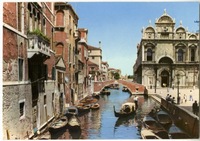 Postcard. Paul B. Moses to Violette de Mazia About 1950, Paul Moses wrote to Violette de Mazia from Europe, joking he once paid for lodging in Venice with a 33⅓ record. Traveling with Philadelphia friends through Capri, Florence, and Venice, he calls Capri the most beautiful place he has seen and looks forward to studying the French Primitives in France with renewed excitement.
Postcard. Paul B. Moses to Violette de Mazia About 1950, Paul Moses wrote to Violette de Mazia from Europe, joking he once paid for lodging in Venice with a 33⅓ record. Traveling with Philadelphia friends through Capri, Florence, and Venice, he calls Capri the most beautiful place he has seen and looks forward to studying the French Primitives in France with renewed excitement.
